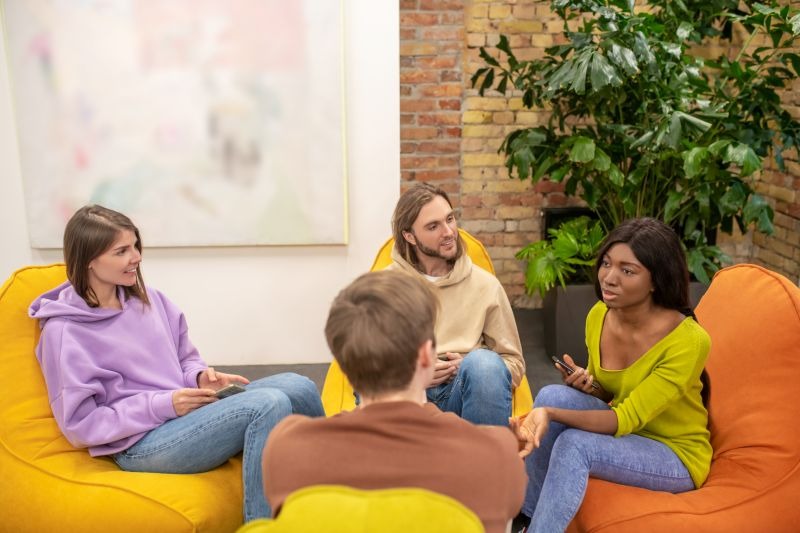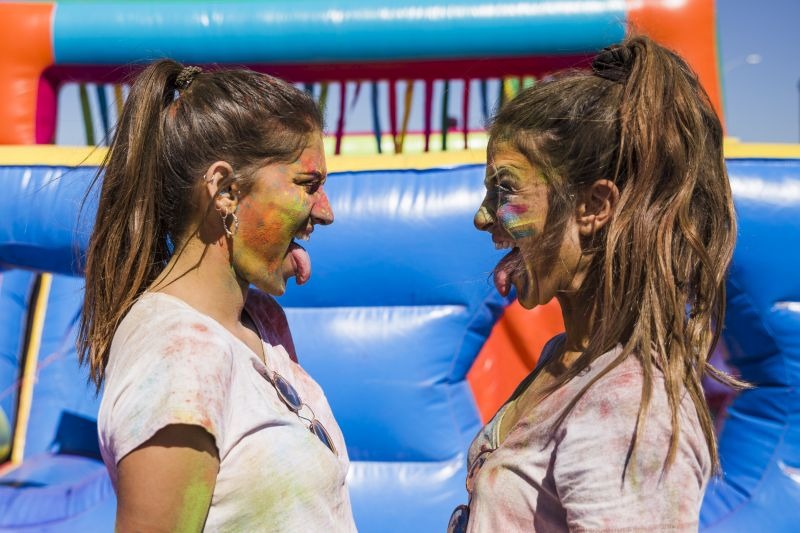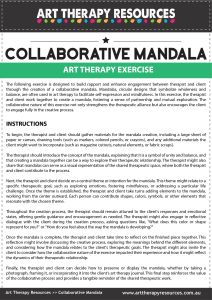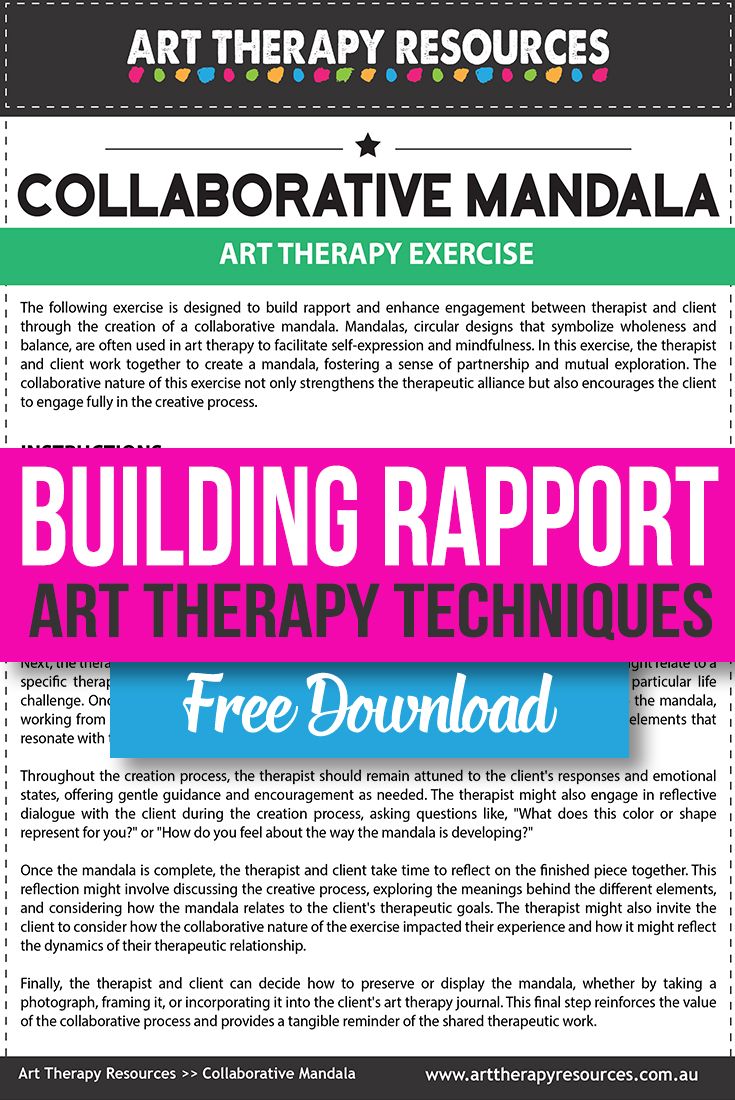THIS POST INCLUDES:
1. The importance of rapport
2. Techniques for Building Rapport
3. Enhancing Client Engagement
4. Free Download Art Therapy Exercise
THE IMPORTANCE OF RAPPORT

In any therapeutic setting, the development of rapport between therapist and client is foundational to the success of the treatment process. This concept is even more pronounced in art therapy, where the non-verbal nature of the intervention often requires a deep level of trust and understanding between the therapist and client. Rapport in art therapy refers to the positive, collaborative relationship that fosters mutual respect, trust, and a shared sense of purpose. It is through this relationship that clients feel safe enough to explore difficult emotions, engage with therapeutic goals, and open up to creative expression.
Rapport is built upon a foundation of empathy, active listening, and the therapist’s ability to create a safe, non-judgmental environment. In the context of art therapy, rapport allows clients to feel that their experiences, both verbal and non-verbal, are understood and validated. This sense of understanding is critical to helping clients feel comfortable enough to express themselves through art, especially when the material they are working through may be emotionally challenging.
Art therapy often involves the exploration of personal and sensitive topics, many of which can be difficult to articulate through words alone. The therapeutic alliance—marked by the strength of the rapport between client and therapist—provides the emotional safety necessary for clients to take risks, express vulnerabilities, and engage deeply in the therapeutic process. Without rapport, clients may feel hesitant or resistant to exploring these deeper issues, which can limit the effectiveness of the therapy.
NON-VERBAL EXPRESSION AND RAPPORT IN ART THERAPY
One of the distinguishing features of art therapy is its reliance on non-verbal communication through the process of art-making. This reliance on creative expression necessitates a therapeutic alliance, as clients must trust that their artwork will be understood and respected by the therapist.
Rapport becomes crucial in this context because it allows the therapist to interpret and respond to the client’s non-verbal communication in a way that is empathic and supportive. When clients trust that their artistic expressions will not be misinterpreted or judged, they are more likely to engage fully in the process. The establishment of rapport ensures that clients feel that the therapist is attuned to their emotional states and can respond appropriately to what is being communicated through the art.
In art therapy, the therapist’s presence and attunement to the client are central to the development of rapport. Therapeutic presence refers to the therapist’s ability to be fully present and engaged with the client during sessions. This presence creates a sense of stability and safety for the client, who may be navigating difficult or unprocessed emotions through the art-making process.
Attunement, a key component of therapeutic presence, involves the therapist’s ability to recognize and respond to the client’s emotional and non-verbal cues. In art therapy, this might mean noticing how the client engages with materials, the colors they choose, or the energy they bring to the creative process. Through attunement, the therapist can align their responses with the client’s emotional state, offering support, validation, or challenge where appropriate.
This attuned presence not only strengthens rapport but also enhances the therapeutic process itself. When clients feel that their emotional expressions—both verbal and non-verbal—are being met with empathy and understanding, they are more likely to trust the therapist and the therapeutic process. This trust is essential for facilitating deeper levels of emotional exploration and creative expression.
BUILDING RAPPORT WITH CLIENTS RESISTANCE TO VERBAL COMMUNICATION
One of the key benefits of art therapy is its ability to reach clients who may struggle with verbal communication. These clients might include individuals with trauma histories, children, or those with developmental or cognitive challenges. For these populations, establishing rapport through traditional talk therapy can be difficult, as they may have limited ability or willingness to articulate their thoughts and feelings verbally.
Art therapy offers a non-verbal avenue for building rapport with these clients. By engaging clients in the art-making process, therapists can create opportunities for expression and connection that do not rely on words. This is particularly important for clients who may feel misunderstood or invalidated by traditional forms of communication. In art therapy, the artwork itself becomes a medium through which rapport is established. As clients create art, they communicate their experiences, and the therapist’s attuned responses to this non-verbal communication help to foster trust and understanding.
For example, with a client who has experienced trauma, engaging in a collaborative art-making activity may help to establish rapport by offering a safe and contained way for the client to begin expressing their experiences. The non-verbal nature of the creative process allows the client to bypass the need for immediate verbal disclosure, while still communicating their emotions and experiences through the art. As the therapist responds empathetically to the client’s artwork, rapport is built, and the therapeutic relationship is strengthened.
RAPPORT THROUGH COLLABORATIVE ART-MAKING
Collaborative art-making exercises can be a powerful way to maintain and deepen rapport in the therapeutic relationship. When therapist and client create art together, the act of collaboration fosters a sense of partnership and mutual exploration. This shared activity creates opportunities for dialogue, reflection, and connection, as both therapist and client contribute to the creative process.
The use of collaborative art-making can also serve as a metaphor for the therapeutic relationship itself. Just as therapist and client work together to create a piece of art, they also collaborate in the therapeutic process to explore the client’s emotional landscape and develop new ways of understanding and coping with life’s challenges. Through this metaphor, clients can experience the therapeutic relationship as a partnership, where both parties are actively engaged in the process of healing and growth.
Additionally, collaborative art-making can help to maintain rapport over time by introducing an element of playfulness and spontaneity into the therapy process. When therapist and client create art together, they share in the joy of creation, which can foster a sense of connection and trust. This shared experience can be particularly helpful for clients who may become disengaged or resistant during more traditional forms of therapy.
ROLE OF EMPATHY AND AUTHENTICITY IN BUILDING RAPPORT
Empathy and authenticity are essential qualities for building and maintaining rapport in art therapy. Empathy involves the therapist’s ability to understand and share in the client’s emotional experiences, while authenticity refers to the therapist’s ability to be genuine and transparent in their interactions with the client.
Empathy is demonstrated through the therapist’s attuned responses to the client’s artwork. By offering reflections that are grounded in the client’s emotional world, the therapist communicates that they understand and respect the client’s experiences. This empathetic engagement helps to build rapport by validating the client’s feelings and creating a sense of safety within the therapeutic relationship.
Authenticity, on the other hand, involves the therapist’s willingness to engage in the creative process alongside the client. When therapists are authentic in their interactions, they model openness and vulnerability, which can encourage clients to take risks in their own self-expression. By being fully present and engaged in the art-making process, the therapist demonstrates that they are an active participant in the therapeutic relationship, rather than a distant observer.
Rapport is a vital component of art therapy that underpins the entire therapeutic process. Through the establishment of a trusting and collaborative relationship, clients are more likely to engage deeply in their creative expressions and explore their emotional landscapes. Techniques such as non-verbal communication, therapeutic presence, and collaborative art-making provide art therapists with practical tools for building and maintaining rapport, ensuring that clients feel safe, understood, and supported throughout their therapeutic journey.
TECHNIQUES FOR BUILDING RAPPORT

Building rapport in art therapy requires intentional and thoughtful engagement from the therapist, and it plays a crucial role in fostering trust, safety, and effective communication between the therapist and the client. Techniques for building rapport in this context are not just limited to verbal exchanges; they also involve attuning to the client’s emotional state, creating a supportive environment, and utilizing the creative process itself to facilitate connection. Below are several key techniques that art therapists can use to build and strengthen rapport with their clients.
1. Active Listening and Attunement
Active listening is a fundamental technique in all forms of therapy, including art therapy. It involves fully concentrating on what the client is saying, both verbally and non-verbally, and responding in a way that reflects understanding and empathy. In art therapy, active listening goes beyond just hearing the client’s words. It also includes observing and responding to the client’s body language, facial expressions, and the choices they make in their artwork—such as colors, themes, and materials.
Attunement, closely related to active listening, involves the therapist aligning themselves with the client’s emotional and psychological state. This requires the therapist to be sensitive to the client’s emotions and responses, both during verbal discussions and in the art-making process. When the therapist is attuned to the client, they can respond in a manner that feels supportive and validating to the client’s experience, helping to build trust and rapport. For example, if a client hesitates before beginning a new piece of artwork, the therapist might gently inquire about their hesitation or offer encouragement, showing that they are attuned to the client’s emotional state.
2. Creating a Safe and Non-Judgmental Environment
In art therapy, creating a safe and non-judgmental environment is essential for building rapport. Clients must feel that they are in a space where they can express themselves freely, without fear of criticism or misunderstanding. The therapist plays a key role in establishing this environment by demonstrating unconditional positive regard—accepting the client’s thoughts, emotions, and artistic expressions without judgment.
To foster this kind of environment, the therapist can begin by emphasizing that there are no “right” or “wrong” ways to create art in therapy. This helps to relieve any pressure the client may feel about producing aesthetically pleasing or technically “correct” artwork, allowing them to focus instead on using art as a means of self-expression. Additionally, the therapist can model openness and curiosity by engaging in art-making alongside the client or by discussing their own relationship to creative expression in a way that normalizes the exploration of difficult emotions and experiences.
This non-judgmental approach can be especially important when working with clients who may have experienced previous trauma, rejection, or criticism in other areas of their lives. Knowing that their artwork—and by extension, their inner thoughts and feelings—will be accepted without criticism can help clients feel more comfortable opening up in therapy, thus strengthening rapport.
3. Offering Empathy and Validation
Empathy is another critical technique for building rapport in art therapy. When the therapist demonstrates empathy, they communicate an understanding of the client’s emotional experience, whether that experience is expressed verbally or through art. This helps the client feel seen and understood, which is a cornerstone of trust in the therapeutic relationship.
Validation is closely related to empathy and involves acknowledging the client’s emotions and experiences as real and legitimate. When a therapist validates a client’s emotions, they help the client feel that their experiences are normal and understandable, which can be particularly important for clients who may feel isolated or misunderstood in their daily lives.
For example, a client may create a piece of artwork that expresses deep feelings of sadness or fear. Rather than minimizing these emotions or trying to “fix” them, the therapist can offer validation by acknowledging the client’s courage in expressing such feelings and affirming that these emotions are a natural response to their life experiences. This validation can help strengthen rapport by demonstrating that the therapist is willing to accept the client’s full range of emotions, without judgment or expectation.
4. Collaborative Art-Making
One of the unique aspects of art therapy is the potential for collaboration between therapist and client in the creative process. Collaborative art-making is a technique that can help build rapport by fostering a sense of partnership and shared exploration between the therapist and the client. When therapist and client work together on a piece of art, the process itself can become a metaphor for the therapeutic relationship, with both parties contributing to the creation of something new.
In collaborative art-making, the therapist and client may work side by side on separate pieces of art or contribute to a shared piece of artwork. This shared creative process can facilitate open communication, reduce feelings of vulnerability, and create a sense of equality in the therapeutic relationship. Through this shared experience, rapport is strengthened as both therapist and client engage in a process that requires cooperation, mutual respect, and trust.
Collaborative art-making can also help break down barriers that may exist in the therapist-client relationship, particularly for clients who may feel intimidated or resistant to traditional talk therapy. By engaging in a shared creative process, the therapist and client can communicate in a non-verbal, symbolic way, which can help build connection and understanding.
5. Incorporating the Client’s Interests and Preferences
An effective technique for building rapport in art therapy is incorporating the client’s interests and preferences into the therapy process. This might involve asking the client what types of art materials or techniques they enjoy using, or inquiring about the themes, symbols, or subjects that resonate with them. By showing a genuine interest in the client’s artistic preferences, the therapist can help the client feel more engaged and empowered in the therapeutic process.
For example, if a client expresses a strong interest in a particular artistic medium—such as watercolor, sculpture, or digital art—the therapist can incorporate this medium into the therapy sessions. This not only helps the client feel more comfortable and connected to the process, but it also communicates that the therapist values their preferences and is willing to tailor the therapeutic approach to meet their needs.
Additionally, incorporating the client’s personal interests—such as nature, music, or literature—into the art therapy process can provide opportunities for deeper connection and engagement. For example, a client who enjoys nature may feel more engaged in a therapeutic activity that involves creating art inspired by the natural world. By aligning the therapy process with the client’s interests, the therapist can foster a sense of collaboration and mutual respect, which strengthens rapport.
6. Using Art to Facilitate Communication
For many clients, especially those who find it difficult to express their thoughts and emotions verbally, art can serve as a powerful communication tool. In art therapy, the therapist can use the client’s artwork as a starting point for discussion, helping to facilitate communication in a non-threatening and indirect way. This can be particularly useful for building rapport with clients who may be hesitant to engage in traditional verbal therapy.
For example, after a client completes a piece of artwork, the therapist might ask open-ended questions about the process, such as, “What was it like for you to create this piece?” or “What does this image represent for you?” These types of questions allow the client to reflect on their own creative process and explore the emotions and thoughts behind their artwork, without feeling pressured to articulate these experiences directly.
By using art as a communication tool, the therapist can build rapport by demonstrating an interest in the client’s creative expression and providing a safe space for exploration. The artwork itself becomes a bridge for communication, allowing the therapist to engage with the client in a way that feels less intimidating or confrontational than direct verbal questioning.
The techniques for building rapport in art therapy are diverse and multi-dimensional, ranging from active listening and empathy to collaborative art-making and the use of art as a communication tool. These techniques are essential for creating a therapeutic environment where clients feel safe, understood, and supported. By employing these approaches, art therapists can foster the trust and connection necessary for effective therapy, encouraging clients to engage fully in the creative process and explore their emotions and experiences in meaningful ways.
ENHANCING CLIENT ENGAGEMENT

Engagement in therapy refers to the client’s active participation and investment in the therapeutic process. In art therapy, fostering engagement involves not only encouraging clients to create art but also helping them to connect with the therapeutic goals and outcomes of their creative work. Engaging clients in art therapy requires a nuanced understanding of their individual needs, preferences, and motivations, as well as the ability to adapt interventions to meet these needs.
One way to enhance client engagement is by integrating personalized art projects into the therapy process. These projects are tailored to the client’s interests, strengths, and therapeutic goals, making the art-making process more meaningful and relevant to the client. For example, a therapist working with a client who enjoys nature might incorporate natural elements into the art therapy sessions, such as using leaves, flowers, or stones in collage work. By aligning the art therapy activities with the client’s personal interests, the therapist can increase the client’s motivation and engagement.
Interactive Art Exercises can also play a significant role in enhancing client engagement. These exercises involve active participation and often include an element of spontaneity or surprise, which can captivate the client’s attention and foster a sense of playfulness. For instance, an exercise might involve the client and therapist taking turns adding to a piece of art, with each addition building on the previous one. This dynamic interaction can stimulate creativity and curiosity, making the therapy process more engaging and enjoyable for the client.
Furthermore, reflective dialogue is an essential component of enhancing engagement in art therapy. After completing an art-making activity, the therapist and client engage in a reflective discussion about the artwork, exploring its meaning, emotional significance, and connection to the client’s life. This dialogue not only deepens the client’s understanding of their creative expression but also reinforces the therapeutic goals of the session. By linking the art-making process to the client’s personal experiences and challenges, the therapist can help the client see the relevance of the therapy to their broader life context, thereby enhancing their engagement.
Building rapport and fostering engagement are essential components of effective art therapy practice. Through the use of creative and collaborative techniques, art therapists can establish strong therapeutic alliances and enhance client participation in the therapy process. The integration of art therapy exercises, such as the collaborative mandala creation, offers a practical and powerful way to achieve these goals, providing clients with a meaningful and engaging therapeutic experience.
In a private practice setting, art therapists can benefit from incorporating these techniques into their work with clients, adapting them to suit individual needs and preferences. By focusing on the relational aspects of therapy and emphasizing the value of shared creative experiences, therapists can create a supportive and engaging environment that promotes healing and growth.
ART THERAPY EXERCISE
Art Therapy Exercise: Collaborative Mandala Creation
The following exercise is designed to build rapport and enhance engagement between therapist and client through the creation of a collaborative mandala. Mandalas, circular designs that symbolize wholeness and balance, are often used in art therapy to facilitate self-expression and mindfulness. In this exercise, the therapist and client work together to create a mandala, fostering a sense of partnership and mutual exploration. The collaborative nature of this exercise not only strengthens the therapeutic alliance but also encourages the client to engage fully in the creative process.
INSTRUCTIONS
To begin, the therapist and client should gather materials for the mandala creation, including a large sheet of paper or canvas, drawing tools (such as markers, colored pencils, or crayons), and any additional materials the client might want to incorporate (such as magazine cutouts, natural elements, or fabric scraps).
The therapist should introduce the concept of the mandala, explaining that it is a symbol of unity and balance, and that creating a mandala together can be a way to explore their therapeutic relationship. The therapist might also share that mandalas can serve as a visual representation of the shared therapeutic space, where both the therapist and client contribute to the process.
Next, the therapist and client decide on a central theme or intention for the mandala. This theme might relate to a specific therapeutic goal, such as exploring emotions, fostering mindfulness, or addressing a particular life challenge. Once the theme is established, the therapist and client take turns adding elements to the mandala, working from the center outward. Each person can contribute shapes, colors, symbols, or other elements that resonate with the chosen theme.
Throughout the creation process, the therapist should remain attuned to the client’s responses and emotional states, offering gentle guidance and encouragement as needed. The therapist might also engage in reflective dialogue with the client during the creation process, asking questions like, “What does this color or shape represent for you?” or “How do you feel about the way the mandala is developing?”
Once the mandala is complete, the therapist and client take time to reflect on the finished piece together. This reflection might involve discussing the creative process, exploring the meanings behind the different elements, and considering how the mandala relates to the client’s therapeutic goals. The therapist might also invite the client to consider how the collaborative nature of the exercise impacted their experience and how it might reflect the dynamics of their therapeutic relationship.
Finally, the therapist and client can decide how to preserve or display the mandala, whether by taking a photograph, framing it, or incorporating it into the client’s art therapy journal. This final step reinforces the value of the collaborative process and provides a tangible reminder of the shared therapeutic work.
Insights on Collaborative Art in Therapy
Collaborative art-making exercises, such as the mandala creation, offer numerous therapeutic benefits, particularly in the context of building rapport and enhancing engagement. These exercises emphasize the relational aspect of therapy, highlighting the importance of partnership and mutual exploration. By working together on a shared creative project, therapist and client can develop a deeper understanding of each other’s perspectives, strengths, and challenges.
One of the key educational insights from collaborative art therapy is the importance of process over product. In collaborative art exercises, the focus is not on creating a perfect or aesthetically pleasing piece of art, but rather on the shared experience of creation. This process-oriented approach aligns with the principles of art therapy, where the act of making art is valued as a means of self-expression, exploration, and connection.
Additionally, attunement and responsiveness are crucial elements in collaborative art therapy. Therapists must remain attuned to the client’s emotional cues, creative preferences, and responses throughout the exercise. This attunement allows the therapist to adapt their approach, providing support, encouragement, or guidance as needed. By being responsive to the client’s needs, the therapist can create a safe and supportive environment that fosters trust and engagement.
Another important aspect of collaborative art therapy is the opportunity for metaphorical exploration. The shared art-making process can serve as a metaphor for the therapeutic relationship itself, with the evolving artwork representing the development of trust, communication, and mutual understanding. By exploring these metaphors, both therapist and client can gain insights into the dynamics of their relationship and the therapeutic process.
FREE DOWNLOAD: Art Therapy Exercise

BUILD YOUR ART THERAPY REFERENCE MATERIALS:
Pin this image to your Pinterest board.

SHARE KNOWLEDGE & PASS IT ON:
If you’ve enjoyed this post, please share it on Facebook, Twitter, Pinterest. Thank you!
